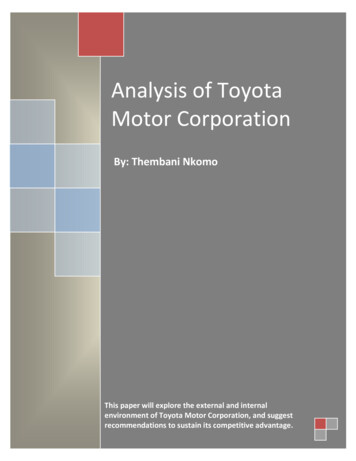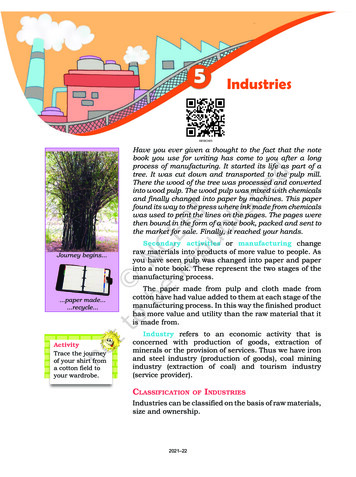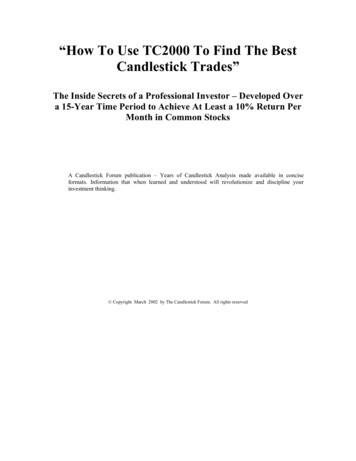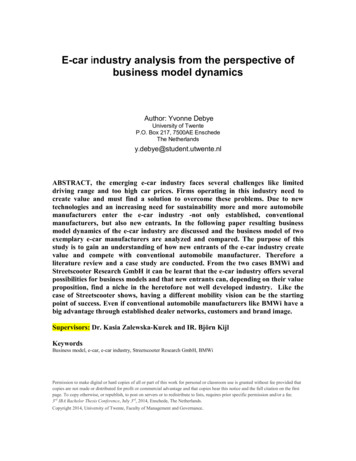
Transcription
Proceedings of the International Conference on Industrial Engineering and Operations ManagementBogota, Colombia, October 25-26, 2017Industry 4.0 and its impacts on societyEduardo Cardoso MoraesFederal Institute of Alagoas - IFALeduardo.c.moraes@ieee.orgHerman Augusto LepiksonFederal University of Bahiaherman@ufba.brAbstractThanks to constant progress in science, we are living in a rapidly evolving world where new trends and technologiesare developed daily. This has an impact on many different areas that impact on society in general, one of which isthe whole field of industry and education. Especially in recent years, much progress has been made in this area,leading to some people talking about the fourth industrial revolution. This article discusses this new revolution, alsoknown as Industry 4.0, addressing the introduction of modern communication and computing technologies tomaximize interoperability across all the different existing systems. Every day we are more connected and able tocommunicate and interact in real time between educational and industrial systems. This article will discuss abouttechnologies that support this new industrial revolution and discuss impacts, possibilities, needs and adaptation.These changes are important steps to meet the growing demand for highly customized products and services,improving resource efficiency and higher throughput.KeywordsCyber-Physical Systems, Industry 4.0, Internet of Things1. IntroductionThanks to constant progress in science we are living in a rapidly evolving world where new trends andtechnologies are developed daily and incorporated into our everyday lives. This has an impact on many differentareas, the real world and virtual reality continue to merge, and allied to this modern information and communicationtechnologies are being combined with traditional industrial processes, thus changing the various production areas.Traditional companies have realized that customers are unwilling to pay large amounts for incremental qualityimprovements. As a consequence, many companies, especially the industries have to adapt their production withfocus on customized products and fast market time, always with lower cost and higher quality. Especially in recentyears, with the progress made in this area, it is believed that we are experiencing the fourth industrial revolution.When talking about this new revolution, also known as Industry 4.0, we are often talking about the introduction ofmodern communication and information control technologies, with increasingly intelligent devices. , In a factory itis sought to maximize the interoperability between all the different existing systems. This interoperability is thebackbone to making a factory more flexible and intelligent, as different subsystems are now able to communicateand interact with each other. These changes are important steps to meet most of today's industrial facility needs,such as the increasing demand for highly customized products, improving resource efficiency and higherthroughput.This article aims to describe briefly the history of industrial evolution and to highlight that we live in a silentindustrial revolution that is due to advances in several areas, especially ICT, and which areas lead these changes.HISTORICAL REVIEWFigure 1 shows a summary of industrial revolutions, where technological advances have driven a dramaticincrease in industrial productivity since the beginning of the Industrial Revolution. In the 1st revolution the steam IEOM Society International729
Proceedings of the International Conference on Industrial Engineering and Operations ManagementBogota, Colombia, October 25-26, 2017engine fed factories in the nineteenth century, in the second revolution electric power raised mass production at thebeginning of the century XX the became automatized with the introduction of computers in 70 s decade.In the decades that followed, however, industrial technological advances were only incremental, especiallycompared to the breakthroughs that transformed IT, mobile communications, and e-commerce. Now, however, weare in the midst of a fourth wave of technological advancement: the rise of the new digital industrial technologyknown as Industry 4.0, a transformation that is fueled by nine fundamental technological advancements and whichare mainly based on Internet of Things (IoT) , Cyber physical systems, Big Data, cloud computing, collaborationsystems, intelligent robots.Figure 1. Graph with a summary of industrial revolutionsThis whole area is being encouraged in a number of countries, especially first world countries, throughmany working groups and opening research projects and funding research activities linking industry and universitiesto promote innovation, but applied innovation and Prototypes at the end. For example, in Germany, the governmentis strongly promoting "Industrie 4.0" and the "Industry Working Group 4.0" was established. Many differentresearch and innovation projects are currently underway, nationally as well as internationally, to build newtechnologies and standards to come to hold the fourth industrial revolution. At the same time, many industrialcompanies, end users and integrators, are showing increasing interest in these results.In this transformation, sensors, machines, parts and IT systems will be connected along the value chainbeyond a single company. These connected systems (also known as physical cyber systems) can interact with eachother using Internet-based protocols and analyze data to predict failure, autoconfiguration, and adaptability tochanges. Industry 4.0 will make it possible to collect and analyze data through machines, allowing for faster, moreflexible and more efficient processes to produce higher quality goods at reduced costs. This, in turn, will increasemanufacturing productivity, shift economics, industrial creative growth with improved and integrated simulation andcollaboration tools.MAIN COMPONENTS OF THE INDUSTRIAL REVOLUTION 4.0 IEOM Society International730
Proceedings of the International Conference on Industrial Engineering and Operations ManagementBogota, Colombia, October 25-26, 2017The Industry 4.0 revolution takes into account important aspects from the technological, industrial andsocial point of view. The so-called Cyber Physical Systems (CPS) are becoming increasingly important in thiscontext, that is, the networking of embedded systems that interact with both other similar devices and with the othersover the Internet. CPS is an evolution of embedded systems because it requires the devices beyond the capacity ofprocessing, communication capacity and an interaction with systems and a corresponding in the virtual world,making the device can be visualized as a virtual tool.Along with increased automation in the industry, the development of intelligent monitoring andautonomous decision-making processes are particularly important in order to be able to optimize processes and addvalue in the entire supply chain almost in real time. We will highlight the main foundations for this revolution.Figure 2. New technologies that are transforming industrial production and are bases for Industry 4.0. ticles/engineered products project business industry 40 future productivity growth manufacturing industries/)SimulationIn the engineering phase, 3-D simulations of products, materials and production processes are alreadyused, but in the future, simulations will be part of an integrated process, from design, with tools that will be IEOM Society International731
Proceedings of the International Conference on Industrial Engineering and Operations ManagementBogota, Colombia, October 25-26, 2017integrated with the Machine code (LADDER, Function Blocks, IEC 61311). This will reduce the gap betweendesign, prototyping and production. These simulations will generate real-time data to mirror the physical world intoa virtual model, which may include machines, products, and humans. This allows operators to test and optimizemachine settings for the next product on the line in the virtual world before the physical transition, thereby reducingmachine setup times and increasing quality.Additive manufacturingCompanies began to adopt additive manufacturing, mainly 3D printing, which is used to produceprototypes and individual components. With advanced manufacture, this manufacturing method will be widely usedfor the production of small batches of custom products which offer advantages of construction such as complex andlightweight designs. With the evolution of 3D printing new materials are being produced with greater strength andwith shorter manufacturing time.For example, aerospace companies are already using 3D printing to apply for new designs that reduce aircraftweight by reducing their spending on raw materials such as titanium.Horizontal and Vertical integration systems: With the advanced manufacture, we seek to have greater control withmore information of the productive process. Sensors, machines, parts and IT systems will be connected throughoutthe value chain of the company and also beyond a single company.CybersecurityAdvanced manufacturing benefits from advances in communication technologies, and with it, they tend toincrease connectivity in all areas. With increased connectivity and use of standard communication protocols, there isa need to protect critical industrial systems and manufacturing lines against cyber security threats. With this, reliablesecure communications as well as sophisticated identity management, machine and user access levels are essential.Augmented Reality: Augmented reality systems support a variety of services such as training, selecting parts in awarehouse, and shipping repair instructions through mobile devices. These systems are currently in their infancy,but in the future, companies will make much broader use of augmented reality to provide workers with real-timeinformation to improve decision-making and work procedures.Industrial Internet and CPS: Cyber-Physical Systems (CPS) can interact with each other using protocolsbased on the Internet standard. Advanced manufacturing will make it possible to collect and analyze data betweendifferent machines, allowing for faster, more flexible and more efficient processes to produce higher quality goodsat reduced costs. This will result in increased manufacturing productivity, turn-by-turn, industrial creative growthwith better integration, simulation and collaboration tools. The CPS topic will be further detailed in topic 2.5.According to Gartner Group (GROUP, 2015) report, which lists technological and strategic trends, in the year 2013more than 50% of Internet connections come from smart devices (called "things"). By 2011, there were more than15 million such devices on the Web, with more than 50 billion intermittent connections. By 2020, we will have morethan 30 billion devices connected, with more than 200 billion with intermittent connections.Cloud computingCompanies are already using cloud computing for some enterprise and management applications, but withadvanced manufacturing, more companies will share production-related information and information, requiringmore sharing and real-time. At the same time, the performance of cloud technologies will improve, reaching reactiontimes of just a few milliseconds. As a result, machine data and features will be increasingly mobilized into the cloud,allowing more data-based services to production systems. Even the systems that monitor and control processes canbecome cloud-based.Autonomous RobotsManufacturing has been using robots to handle complex services, but robots are evolving to greater utility. They arebecoming more autonomous, flexible and cooperative. Eventually, they will interact with each other and work hand IEOM Society International732
Proceedings of the International Conference on Industrial Engineering and Operations ManagementBogota, Colombia, October 25-26, 2017in hand with humans safely and learn from these. Robots tend to cost less and have a greater range of features thanthose used in today's manufacturing. For example, Kuka, a European robot manufacturer, offers autonomous robotsthat interact with each other. These robots are interconnected so they can work together and automatically adjusttheir actions according to the next product on the production line. Sensors and control units allow closecollaboration with humans. Similarly, another supplier of ABB robots, is launching a two-armed robot called Yumithat is specifically designed to mount products alongside humans. Two padded arms and computer vision allow forsafe interaction and recognition.Big dataBig Data is a term that is on the rise and is used for very large or complex datasets where traditional data processingapplications are insufficient. Challenges include analyzing, capturing, selecting data, grouping, searching, sharing,storing, transferring, viewing, and information about privacy. In the industrial area it can optimize productionquality, save energy and improve the service of equipment. In the context of Industry 4.0, one has to integrate datafrom different equipment many different production sources and systems, as well as to enterprises and customermanagement systems, will become standard to support real-time decision making.IoTInternet of Things or "Internet of Things" (IoT) is a new paradigm that is rapidly gaining ground in the industry atlarge. According to Giusto (2010), "the basic idea of this concept is the generalized presence around us of a varietyof things or objects like Radio-Frequency Identification (RFID), sensors, actuators, cell phones, etc. Which, throughunique addressing schemes, are able to interact with each other and cooperate with their neighbors to reach commongoals.These devices will have more and more applications in our day to day and especially for the industries, where agreater possibility of product tracking, inter and intra-company interaction, automated control of the systems wherein a production line the products themselves will have a Tag that will guide them by which machine and which lineof production to follow, with that after each stage, and register information about the analyzes made. This canreduce the use of resources, because you will have more real-time information about their use and downtime andperformance, with an emphasis on energy reduction.This concept is key in this process and from it a number of other paradigms, methodologies and processes have tofit.Cloud ComputingCloud Computing is supposed to transfer business process facilities to a place that is virtually accessed over theInternet, regardless of physical distance or "clouds." With the maturation of cloud computing we will increasinglyhave cloud-based systems, so industrial systems will make machine and production data available in the clouds,enabling a new form of decision-making associated with greater horizontal and vertical integration in the cloud.Pyramid of industrial automation.Horizontal and Vertical IntegrationEven today, most IT systems today are not fully integrated. Companies, suppliers and customers are rarelyclosely connected. Neither are departments in-house, such as engineering, production, and services. Companyfunctions for factory floor level are not fully integrated. Even designing itself from automation plant products doesnot have complete integration. But with Industry 4.0, businesses, departments, functions and capabilities havebecome much more cohesive, for example, shared CRM systems (Customer Relationship Management) that allowvalue chains to truly be deployed. And the traditional pyramid of industrial automation will become flat where you IEOM Society International733
Proceedings of the International Conference on Industrial Engineering and Operations ManagementBogota, Colombia, October 25-26, 2017can access data from any machine and where the machines will exchange information and become moreautonomous.As described above the introduction of new paradigms from TICC (Technology Information Communicationand Control) will have huge impacts on virtualization of the process and supply-chain ensures smooth intercompany operations providing real-time access to relevant product and production information for all participatingentities. In this scenario boundaries of companies fell behind, as autonomous systems exchange data, gained byembedded systems throughout the entire value chain. The companies that will not be ready for these transformationsare tied to die.2.CONCLUSIONIndustry 4.0 will address and create solutions for some of the challenges facing the world today such asresource and energy efficiency, urban production and demographic change. Industry 4.0 enables continuous resourceproductivity and efficiency gains to be delivered across the entire value network. It allows work to be organized in away that takes demographic change and social factors into account. Smart assistance systems release workers fromhaving to perform routine tasks, enabling them to focus on creative, value-added activities. In view of the impendingshortage of skilled workers, this will allow older workers to extend their working lives and remain productive forlonger. Flexible work organization will enable workers to combine their work, private lives and continuingprofessional development more effectively, promoting a better work-life balance.This paper discussed key technologies like cloud computing, IoT, CPS for the deployment of a newindustrial revolution called Industry 4.0. This new paradigm will benefit from the latest TICC (InformationTechnology, Communication and Control) technologies associated with greater collaboration among the players inthis industrial process.This change is already impacting the industrial area, especially in areas where the product life cycle issmall and a constant search for improvement is needed, such as the electronics, automotive and aviation sectors. Weneed to train trained professionals to work and reason with a more global vision and knowledge permeate indifferent areas, which will be more closely linked. There is an open field for creating platforms, new or improvedprotocols, and connections between smart devices that allow you to use these new features in factory environmentsthat are provided in Industry 4.0. You must completely develop new business models and exploit the considerablepotential for optimization in the areas of production and logistics.ReferencesATZORI, Luigi, Antonio Iera, and Giacomo Morabito. "The internet of things: A survey." Computer networks 54.15(2010): 2787-2805.BRETTEL, Malte, et al. "How virtualization, decentralization and network building change the manufacturinglandscape: An Industry 4.0 Perspective." International Journal of Science, Engineering and Technology 8 (1), 37 44(2014).CHUI, Michael, Markus Löffler, and Roger Roberts. "The internet of things." McKinsey Quarterly 2.2010 (2010):1-9.INDUSTRY 4.0: The Future of Productivity and Growth in Manufacturing Industries. Boston. BCG Perspectives.Disponível em: IEOM Society International734
Proceedings of the International Conference on Industrial Engineering and Operations ManagementBogota, Colombia, October 25-26, es/engineered products project business industry 40 future productivity growth manufacturing industries/ . Acessed in: 05/14/2017MORAES, Eduardo Cardoso, Herman Augusto Lepikson, and Armando Walter Colombo. "Developing InterfacesBased on Services to the Cloud Manufacturing: Plug and Produce." Industrial Engineering, Management Scienceand Applications 2015. Springer Berlin Heidelberg, 2015. 821-831.Zhang, Lin, et al. "Key technologies for the construction of manufacturing cloud." Computer IntegratedManufacturing Systems 16.11 (2010): 2510-2520.Reimer, D., and Ali, A., Engineering education and the entrepreneurial mindset at Lawrence Tech, Proceedings ofthe International Conference on Industrial Engineering and Operations Management, Istanbul, Turkey, July 3 –6, 2012.Shetty, D., Ali, A., and Cummings, R., A model to assess lean thinking manufacturing initiatives, InternationalJournal of Lean Six Sigma, vol. 1, no. 4, pp. 310-334, 2010.Srinivasan, G., Arcelus, F.J., and Pakkala, T.P.M., A retailer’s decision process when anticipating a vendor’stemporary discount offer, Computers and Industrial Engineering, vol. 57, pp. 253-260, 2009.BiographyEduardo Cardoso Moraes is a Professor at Federal Institute of Alagoas. He earned B.S. in Computer Science inUFAL(Federal University in Alagoas State) Masters in Computer Science from UFPE(Federal University inPernambuco State), and PhD in Industrial Engineering from UFBA (Federal University in Bahia State). He haspublished many journal and conference papers. Dr Moraes is a reviewer form IEEE Industrial Informatics Journaland CONNEPI. He has completed international PhD exchange in Germany supervised by Prof. Dr. ArmandoWalter Colombo. His research interests include manufacturing, industrial informatics, services-based systems, agilemethodologies. He is member of IEEE and Brazilian Computer Society.Herman Lepikson - Director of the Senai Institute for Innovation in Automation and former Associate Professor atUFBA (Federal University in Bahia State). He got Doctor and Master degree in Engineering from UFSC inManufacturing Systems; He is Specialist in Economic Engineering from PUC-MG), and graduated in MechanicalEngineering from UFBA, all institutions from Brazil.He is DT2 researcher (Technology Development, level 2) of CNPq (National Research Council).His research work is in the following areas: manufacturing integration, mechatronic systems design and technicalsystems accuracy. He coordinates the CNPq Research Group on Manufacturing Integration and he is permanentProfessor of the Graduate Programs in Mechatronics and Industrial Engineering at UFBA, in which he advisesmaster and doctorate students. IEOM Society International735
Industry 4.0 and its impacts on society. Eduardo Cardoso Moraes . Federal Institute of Alagoas - IFAL eduardo.c.moraes@ieee.org. Herman Augusto Lepikson . Federal University of Bahia . herman@ufba.br . Abstract . Thanks to constant progress in science, we are living in a rapidly evolving wor











